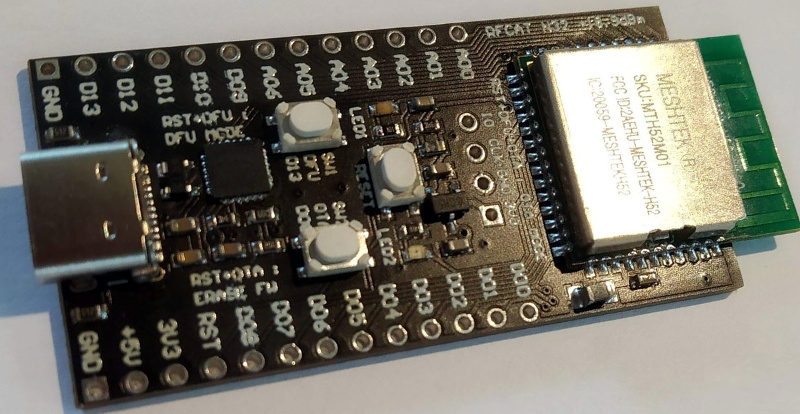Have you ever come across an interesting chip or component that you wanted to experiment with, only to find that there doesn’t seem to be a development board for it? Spinning up your own board is a lot easier today than it has been in the past, but it’s still a bit of a hassle to do it just for your own personal use. This is why [Nikolaj Andersson Nielsen] has decided to release RFCat, his custom long-range Bluetooth development board, onto the community.
 The board is based around a module from MeshTek that’s essentially an amplified version of the Nordic nRF52832. According to [Nikolaj], this gives the module 30 times the transmit power of the base model chip.
The board is based around a module from MeshTek that’s essentially an amplified version of the Nordic nRF52832. According to [Nikolaj], this gives the module 30 times the transmit power of the base model chip.
RFCat is compatible with the Arduino IDE and uses the Adafruit nRF52 bootloader, making it easy to write your own code to take advantage of all this new-found power. Primarily you’d be programming the board over USB-C, but it also supports Serial Wire Debug (SWD) and over-the-air updates that can be triggered with a physical push button on the device.
If you want to get an RFCat of your own, it’s available on Tindie now. The amplified modules were originally intended for building Bluetooth mesh networks, but we’re sure there are other interesting applications out there just waiting to be discovered.
















So, by “higher power”, is it within legal (FCC) limits?
P.s. nice cat graphic/logo on the PCB
FCC most likely yes. You have many +20bBm ble modules. ETSI not with ble, but a custom radio protocol can comply.
Looks like it’s a pre-built little radio module with shielding and everything. I’m sure it’s FCC-approved in that case.
Unless you’re building products and marketing them, though, I wouldn’t even worry about it.
If frequency hoping is used you can use +20dBm even within ETSI limits.
But for long range you really want 125kbps coded phy, range increase is done without having insane power consumption (for a BLE device).
I feel like I’ve been left behind! I started learning electronics when components were very large and now so small you need a microscope. All of this new stuff like Arduino, Raspberry, Latte Panda, and micro sized desktops no bigger than a cigar box. Wow! I felt the same way building a kit with one 7-segment led and left wondering why it didn’t work? The old way in the military was light bulbs, tubes, and easily replaceable components. Right now I’ve gone back to studying BJT’s, FET’s, MOSFETS, and digital. This also includes studying for my General Class Exam for Amateur Radio. Oh well, rather learn to swim than drown!
It is probably worth pointing out that this board/chipset works only with Bluetooth Low Energy, not Bluetooth Classic (the Nordic nRF52 series of SoCs are not capable of supporting classic Bluetooth). That could be a dealbreaker for some.
Also, it is a bit pity that the board uses the nRF52832 and not the more capable nRF52840 – more flash, more RAM, native USB interface (including DFU bootloader) and more protocols supported. That’s important if you want to run e.g. mesh – nRF52832 supports only Bluetooth Mesh but not Thread or Zigbee because the stack won’t fit into the limited memory.
So, without digging datasheets, can this dev board be retro-fitted (or just fitted straight up) with the higher spec chip?
Yeah max 2Mbps and even on Nordic chips that can support 802.15.4 the upper limit is listed on the datasheets as iirc ~200kbps or something like that. The newer nrf52811 supports thread, 833 also including usb, and already soft-released dual core 5340 which is a beast… I’d check out the fanstel bt40f module which is one of the first 5340 ones I’ve seen available although sold out now, it’s also pin to pin compatible with a bunch of their other modules (bt840_ line being the same and already released for 52840) and the upcoming bt40x which will use nordic’s new power amplifier in addition to the beefy onboard antenna that comes with their F series… Anyway this dev board here is a relatively simple pcb, literally just the SoC and USB serial IC with some passives, I’d say nearly any noob who just likes Arduino stuff and knows ohm’s law can hop on EasyEDA where all this stuff has easily searchable footprint libraries, take no more than a week to learn the basics on YouTube, then drop $20-50 between pcb fab and enough components for a handful of boards you can solder yourself with maybe 0805 passives and using only the side castellated module pins (or get a hot air station, oven, etc…) I’m all for more open hardware being out there but like if your needs are still more specific, don’t complain the moment someone provides another option lol — be the change you want to see
But why? Why on Earth Bluetooth is still exist?
Because nobody fits IrDA any more.
BLE, not BT. And it’s here to stay.
Well this is confusing, I was looking for rfcat, the already very well established in the RF hacking community, but getting BLE. Was there no effort to google the naming? It’s just gonna get annoying when there’s an active community already.